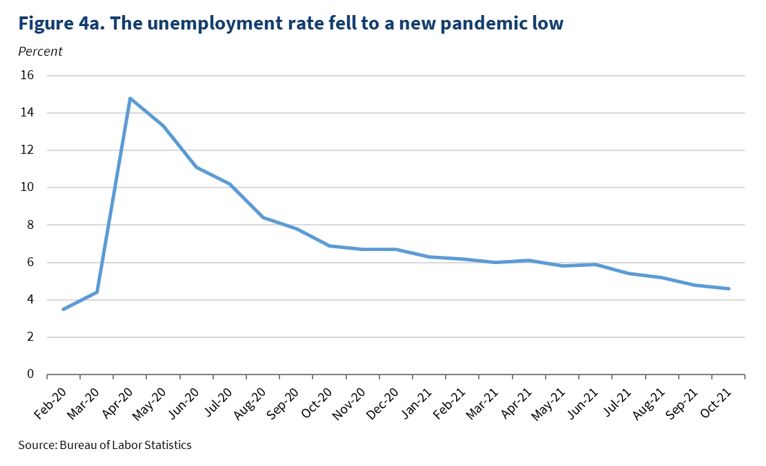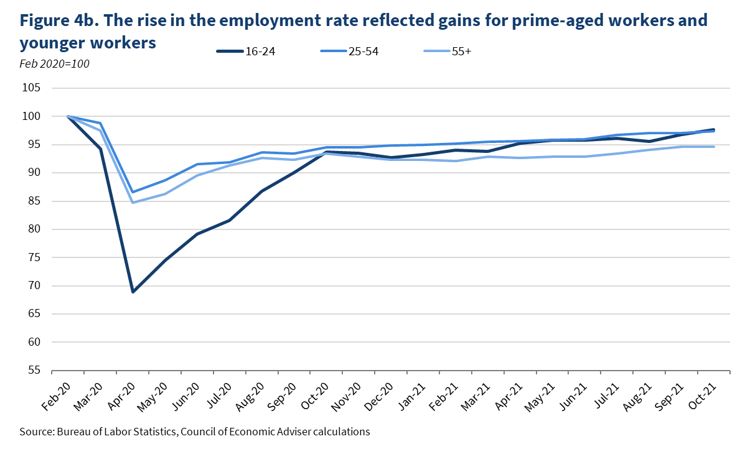The Employment Situation in October
By Chair Cecilia Rouse
The economy added 531,000 jobs in October according to today’s jobs report, for an average monthly gain of 442,000 over the last three months. The number of jobs added in October came in above market expectations, partly reflecting an improvement in the public health situation. Job gains in August and September were revised up by a combined 235,000.
In addition, the unemployment rate fell by 0.2 percentage point to 4.6 percent as labor force participation held steady and the employment rate reached a new pandemic recovery high. This is the lowest the unemployment rate has been since the pandemic began. Before the Rescue Plan was passed, the Congressional Budget Office projected that it would take until the fourth quarter of 2023 to reach a 4.6 percent unemployment rate. With today’s report, the economy reached that rate two full years earlier than projected. Wages rose by 0.4 percent over the month, for an increase of 4.9 percent year-over-year. Wage growth has been relatively rapid in recent months as employers try to hire as the economy recovers.
It is important to focus on the trend of data across multiple months, since any one month of data could be volatile. This report is also a reminder that the economic recovery relies heavily on recovery from the COVID pandemic.
- Job growth over the last three months has averaged 442,000, a solid pace.
Job growth from August to October averaged 442,000 jobs per month (see Figure 1). Since monthly numbers can be volatile, it is important to focus on the three-month average rather than the data in a single month, as described in a recent CEA blog.

Nevertheless, the labor market has not fully recovered: employment remains about 4.2 million jobs (2.8 percent) below its pre-pandemic level.
2. Job growth in August and September was revised up substantially, suggesting job growth was stronger in those months than previously thought.
Job growth in August and September was revised up to 483,000 and 312,000, respectively. Jobs numbers are generally revised twice before they are considered relatively “final.” Revisions have been relatively strong in recent months, averaging almost 97,000 per month so far this year (compared to an average of 10,000 per month in 2019, before the pandemic) when looking at the first and second revisions combined. Over the last four months, the first revision alone has added about 112,000 jobs each month on average.

The strength of the revisions in recent months is an important reminder of how difficult it is to measure the economy during a pandemic.
3. Leisure and hospitality has accounted for more than 40 percent of the job growth in 2021.
Employment growth has generally improved across industries. For instance, while employment in leisure and hospitality (the industry hardest hit by the pandemic) is still 8 percent below where it was in February 2020, it has added 2.4 million jobs in 2021. It has accounted for more than 40 percent of the job growth in 2021. Overall, leisure and hospitality, professional and business services, education and health services, and government have accounted for 70 percent of the job growth in 2021, despite being only 56 percent of overall employment in February 2020.

Employment in transportation and warehousing is actually now above where it was pre-pandemic, and employment in financial activities has also recovered to its February 2020 level.
4. The unemployment rate fell as workers found jobs and the labor force held steady.
The unemployment rate fell to 4.6 percent, its lowest rate since the pandemic took hold, as seen in Figure 4a. The unemployment rate is not only affected by workers finding or losing jobs, but also by workers choosing to start or stop looking for work (that is, entering or leaving the labor force). The decline in the unemployment rate this month reflected an increase in employment, as the employment-population ratio rose to 58.8 percent—a new high of the pandemic recovery—and as labor force participation held steady. The labor force participation rate has remained between 61.6 and 61.7 percent since April 2021. During the Great Recession recovery, the labor force participation rate did not reach its lowest point until 2015, about eight years after the recession started.

The employment rate ticked up to 58.8 percent, the highest it has been during the pandemic recovery, largely reflecting increases in employment among workers age 25 to 54 (“prime-age workers”) and workers age 16 to 24 (see Figure 4b). Employment for those age 55 and over held steady.

Employment is least recovered for workers age 55 and over, partly reflecting the increase in retirements during the pandemic.
5. The percent of individuals who said their work decisions were impacted by COVID fell to new pandemic lows in October.
As the rate of new COVID cases slowed in October, workers were less likely to say that their work decisions were being affected by COVID. Only 1 percent of those out of the labor force did not look for work because of COVID, and similarly, only 1 percent of the population was unable to work because of COVID. The percent of workers teleworking also fell.

The decline in these numbers comes after relative stagnation in August and September, reflecting the improving public health situation.
As the Administration stresses every month, the monthly employment and unemployment figures can be volatile, and payroll employment estimates can be subject to substantial revision. Therefore, it is important not to read too much into any one monthly report, and it is informative to consider each report in the context of other data as they become available.

